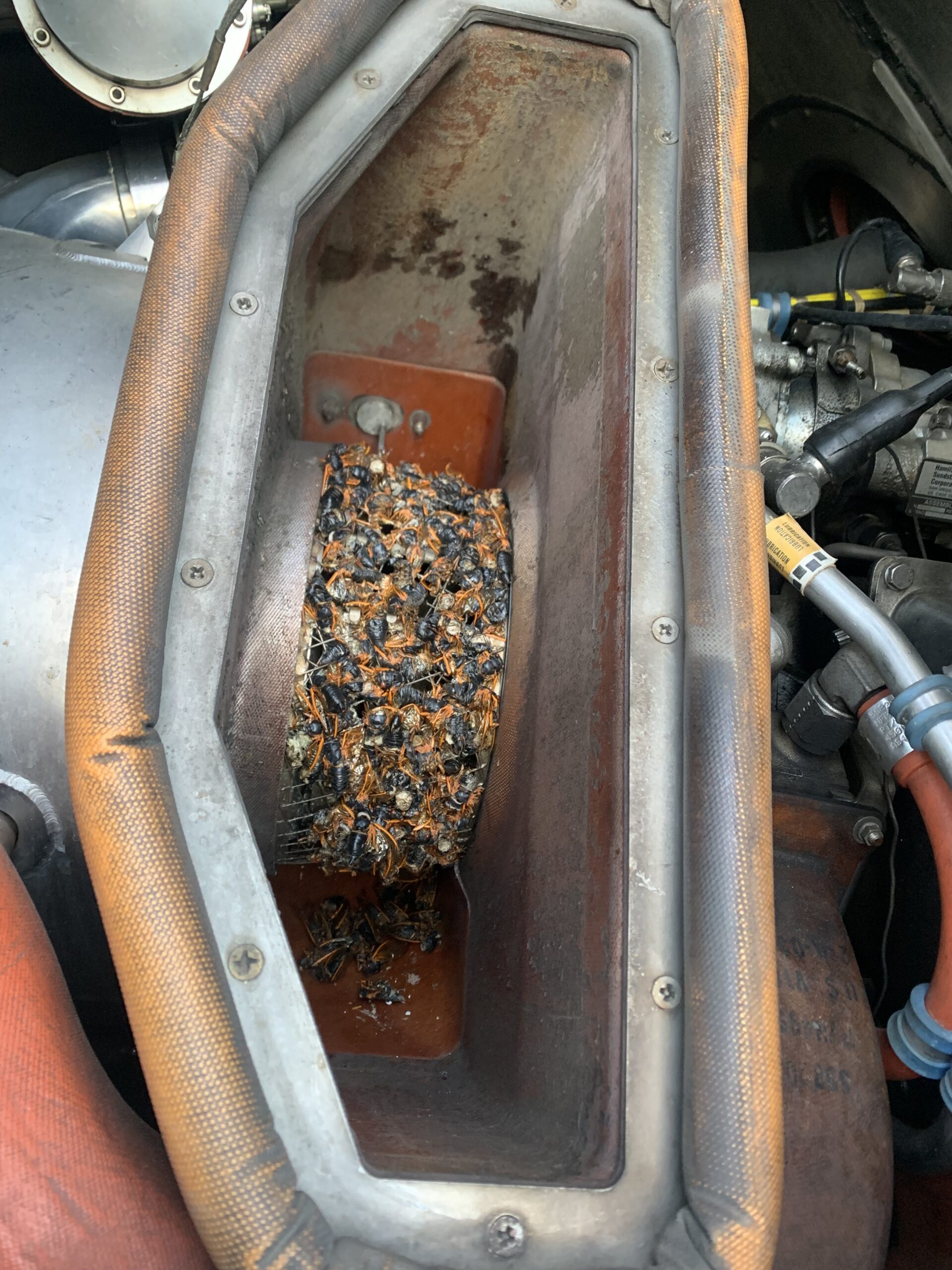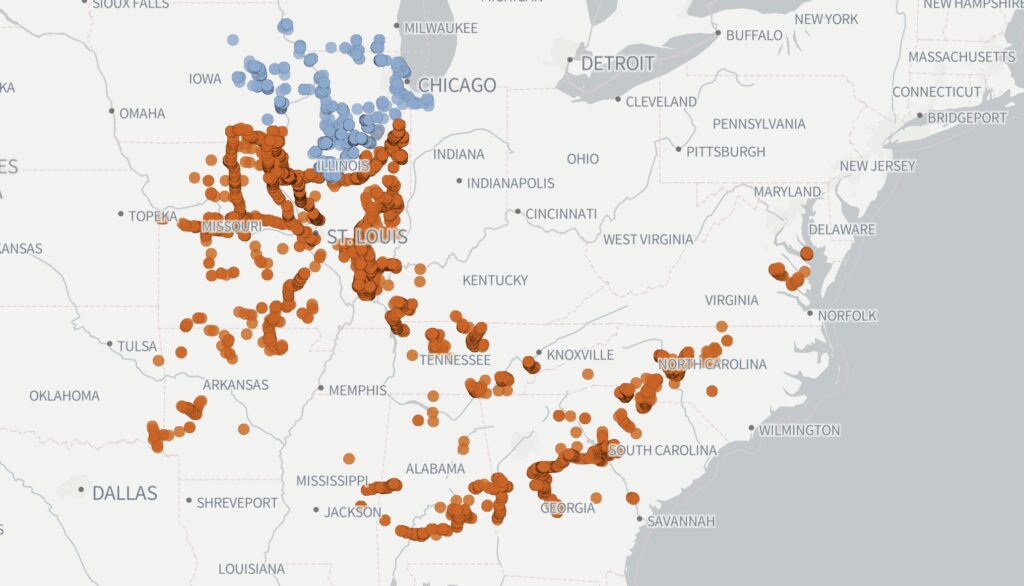This spring, the US Midwest will see Cicada’s emerging in numbers that have not been seen in generations.
This is quite frankly terrifying. It may sound ridiculous that something like this matters, but rest assured, it is crucial. I know from first-hand experience.
It was a hot summer afternoon in 2021 on the ramp at KSUS/Spirit of St Louis airport. There were massive bugs EVERYWHERE, buzzing around, hitting you in the head, flying into the rental car or aircraft if the door was open for even ONE second. Their dead bodies were scattered across the ramp from being run over or stepped on. It was Cicada swarming season, according to the line guys.
We had the APU running and the main cabin door open, attempting to cool the cabin while waiting for our passengers. Even with the curtain closed, the Cicadas entered the cabin and cockpit through the cracks. It was truly disgusting, and I still have nightmares to this day.
The captain was busily chasing the bugs around, attempting to capture each one and throw it back outside. Meanwhile, the FA and I were cowering in the corner, trying to stop them from flying into our hair. When the passengers arrived, they DASHED as fast as they could from their SUV towards the aircraft, hoping to escape getting hit in the face by a Cicada (spoiler: they did not escape this). The SECOND we opened the curtain for them to run in, a load more Cicadas flew in, and we were back to square one, trying to capture/dispose of each one. I heroically went outside, hastily loaded the bags, and shut the cargo door. We had no choice but to close the main cabin door with many 2-3 inch bugs still hiding inside.
Our attempt to escape was met with a HUNG START. QRH blah blah… after several minutes on the phone with our maintenance department and a few more attempts, we were fresh out of ideas. Right then, a frightened Cicada almost flew right into my mouth, prompting the realisation, that, of course this unique variable must be the thing causing the problem.
A quick climb up a ladder confirmed that the APU intake was COVERED in dead Cicadas. It wasn’t getting enough air to provide high-load pneumatic functions. We got a ladder and a broom and brushed some cicada-carcass off the intake, a feeble attempt in rectifying a problem that was concentrated far deeper than the external grate. Somehow, though, we managed to get #1 running (it took precisely 59 seconds, of course), and we were off to the races.
As we taxied off the ramp the most foul, PUTRID smell began to penetrate our nostrils. The smell of HOT/DEAD/LARGE BUGS is not a smell I’d wish on my worst enemy. We quickly switched the bleeds over to the engines and prayed for no circumstances requiring us to switch them back.
Upon arrival, our maintenance team opened the APU and manually removed the burnt cicada crust. It took almost a year for the smell to be removed entirely from any APU-fed PACK usage. We would later learn that Cicadas are attracted to the high-pitched sound of the APU, hence so many of them flew into the intake.

APU Intake – Side order of Cicada
If you’re still reading, I’m surprised, but here’s the point: this year is supposed to be the most giant Cicada swarm in decades across the Midwest, specifically concentrated in Illinois (St.Louis and Chicago). Allegedly this swarm will be at least twice as large as the one in the story above.
For my crews, given that we will likely find ourselves in these locations this spring, I’ve set out the following procedures for operating in a Cicada swarm (think of it like you would a cold weather operational procedure):
- Do not run the APU until RIGHT before you want to start the engines.
- Attempt to leave all aircraft doors shut as much as possible.
- If it is very hot and the swarms are very bad, try to get a hangar the night before departure. Also, have the aircraft put online as close as possible to departure so that the cabin isn’t extremely hot for passenger boarding
- As a precaution ahead of departure, research whether an air cart is available on the field and what the procedures would be to get it (just in case).
I hope our “Cicada QRH Actions” can save you a new cabin fragrance for your aircraft this spring!
Got a story to share? Let us know!
If you come across a new risk, a new danger, a new procedure, something weird, something unusual – tell us, and we’ll tell everyone in the group.
More on the topic:
- More: Teterboro: RIP the RUUDY SIX
- More: 400% increase in GPS Spoofing; Workgroup established
- More: GPS Spoofing WorkGroup 2024
- More: New GAR Procedure for UK Flights
- More: New APIS system coming to Hong Kong
More reading:
- Latest: Teterboro: RIP the RUUDY SIX
- Latest: 400% increase in GPS Spoofing; Workgroup established
- Latest: GPS Spoofing WorkGroup 2024
- Safe Airspace: Risk Database
- Weekly Ops Bulletin: Subscribe
- Membership plans: Why join OPSGROUP?












 Get the famous weekly
Get the famous weekly 





